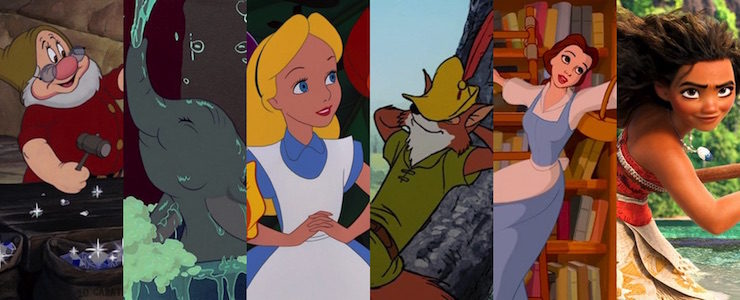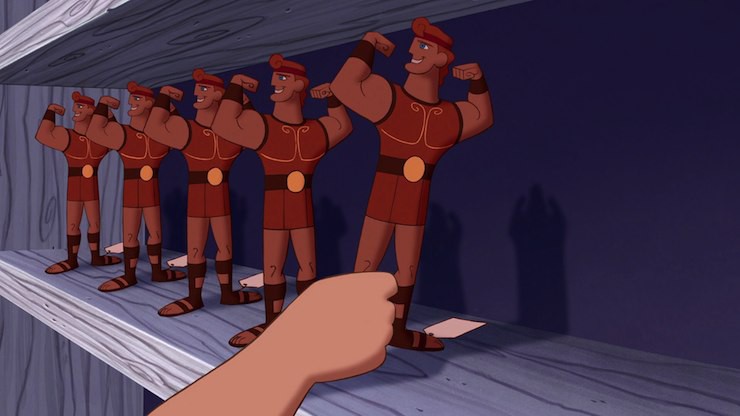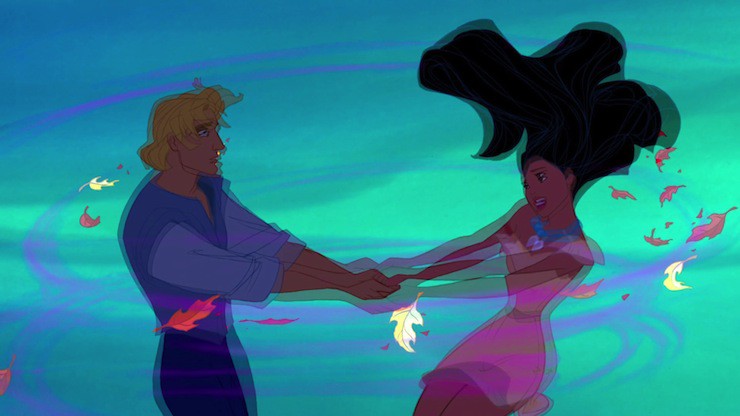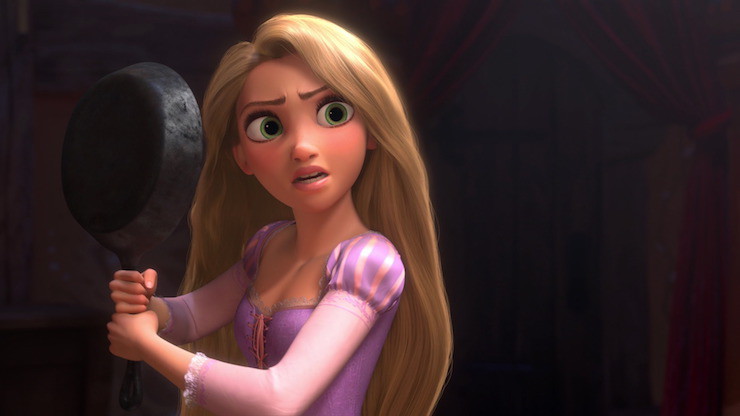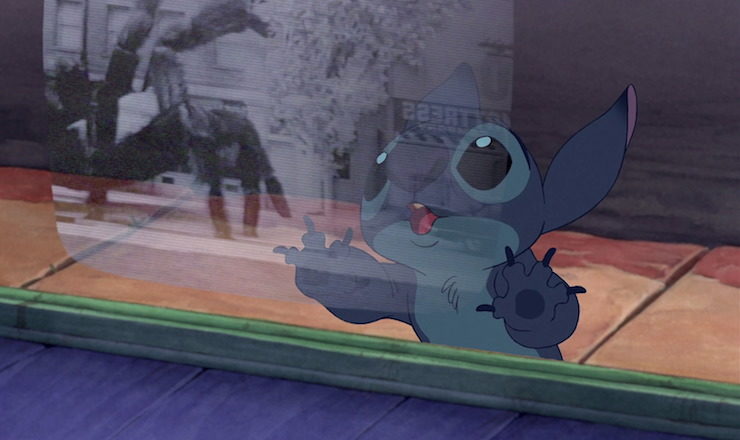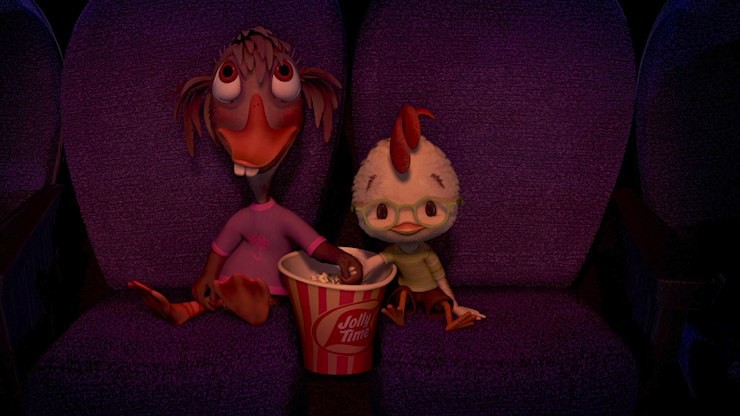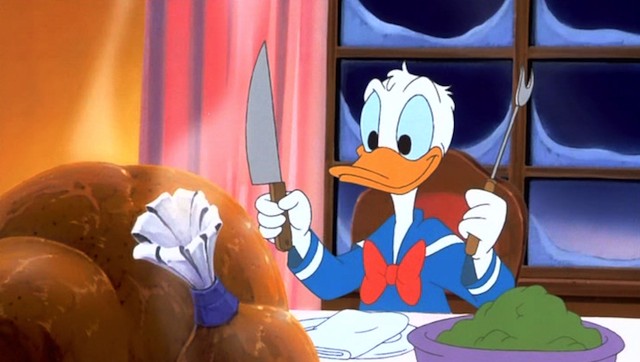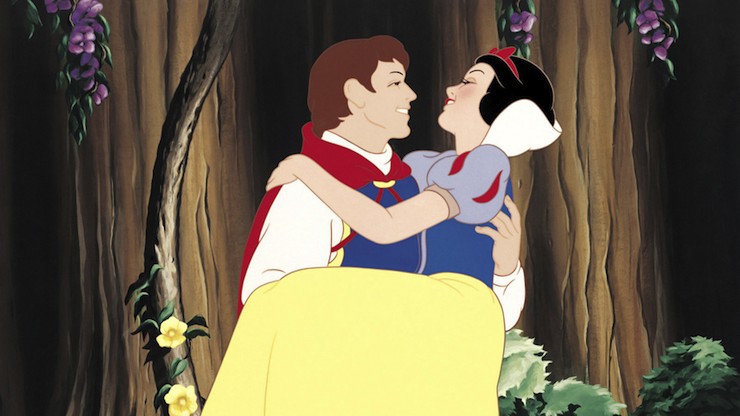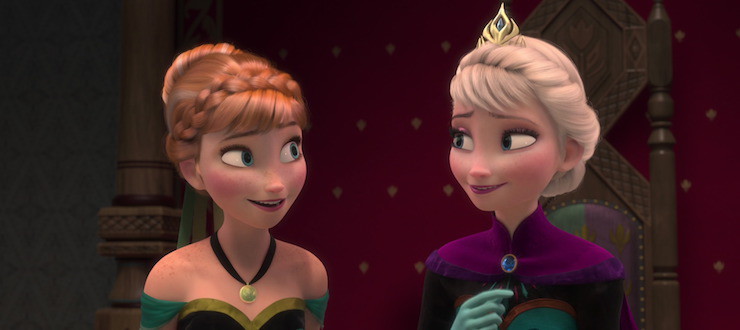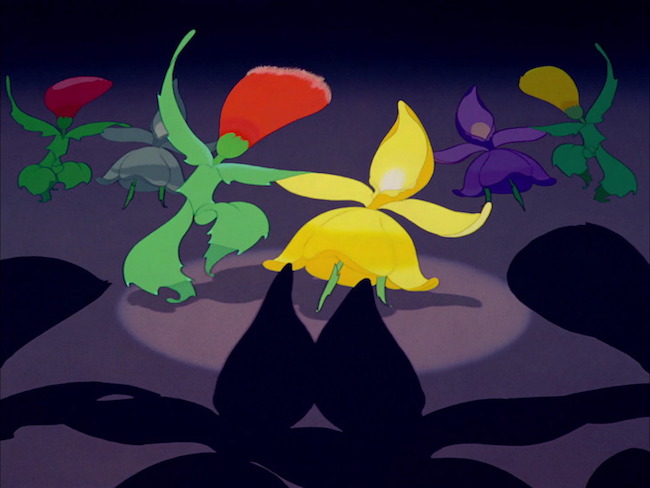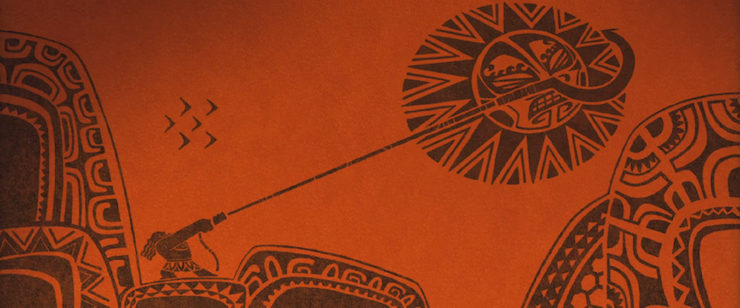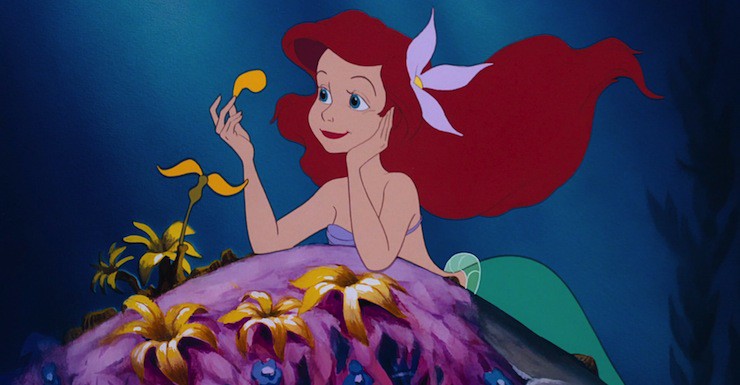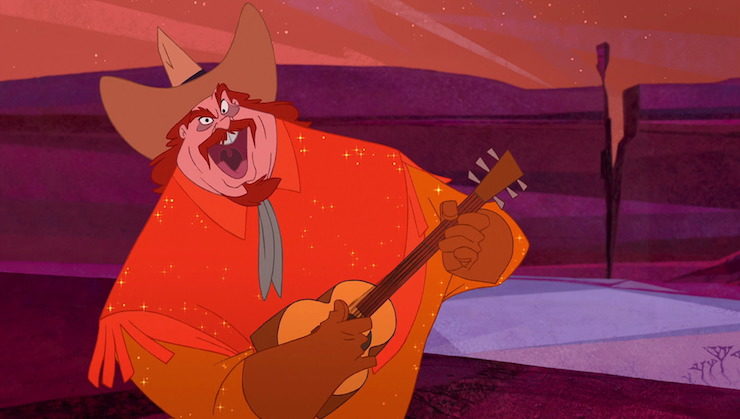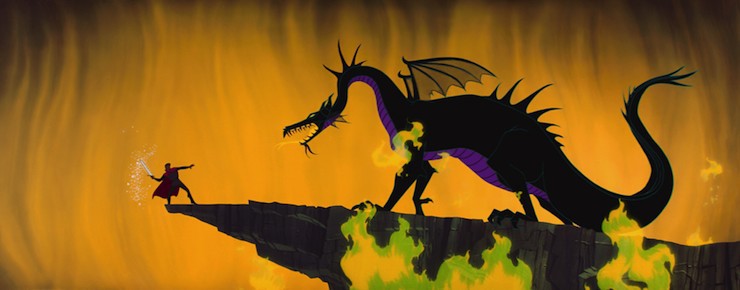Fifty-eight—58—films. Thirty—30—sources. Plus some very disturbing revelations about Daisy Duck.
Now that the Disney Read-Watch is over, the powers that be at Tor.com and I thought it might be fun to do a review of the series. Starting with:
What did we learn from all this?
(1) That for a studio that spent a good two-thirds of its existence under the threat of bankruptcy or shutdown, the Disney Animation Studios managed to churn out an impressive number of films—at least one film per year in the 1940s, the 1990s and the 2000s, plus films in the intervening decades. This is even more impressive when you consider just how labor intensive animated films are, with nearly every Disney film taking at least three and often four to five years to complete, with the exception of the package films.
(2) As a result, going through these films became not just a story of the development of animation in feature films, but a story of constant struggle to keep down costs for the studio—a struggle that regrettably led to the delay or even cancellation of multiple projects, but also led to the development of new animation techniques, ranging from watercolor to xerography to the CAPS system to, finally, computer animation—with a tiny return to hand animation in the latest release, Moana.
(3) Although only a few films—Victory Through Air Power, Saludos Amigos, and Bambi—were created as direct responses to current events, like all art, Disney films remain very much a product of their times, shaped not only by commercial and artistic concerns, but contemporary politics. This can be seen in everything from the large environmental themes of The Lion King and Pocahontas, to the small detail of allowing the entire continent of Africa only one representative in the 1970s The Rescuers while later showing multiple African countries in its early 1990s sequel, The Rescuers Down Under.
In other cases, Disney films can be seen, in retrospect, to be reflecting the traumas and anxieties of the times that created them. Thus, the 1937 Snow White and the Seven Dwarfs contains several scenes echoing the labor concerns of the Great Depression; the 1941 Dumbo deals with the reality of the often violent, forced family separations of wartime Europe (and ends on a war note); the 1951 Cinderella, created after the collapse of most aristocracies in Europe, believes in hard work more than it believes in princes; the 1997 Hercules uses a Greek myth to mock U.S. consumer culture.
(4) Disney in the 1930s and 1940s was not exactly a model of racial integration; nonetheless, until the 1990s, the three Disney films with the largest numbers of non-white characters were all from the 1940s: Saludos Amigos (1943), The Three Caballeros (1945), and Dumbo (1941)—the last of which, incredibly enough, held the record for the most black characters in a Disney film until The Princess and the Frog (2009). That is partly because between The Three Caballeros and Aladdin (1992) Disney released a grand total of one film featuring non-white characters, The Jungle Book (1967), unless we’re counting the international mice in The Rescuers (1977)—most of whom are from Europe.
(5) Disney’s idea of “adapting” source material could vary wildly, from reasonably close adaptations of the original (One Hundred and One Dalmatians), to transforming pretty much the entire plot and quite a bit of the ethics (Hunchback of Notre Dame; The Fox and the Hound), to keeping a couple of character names and not much else (Oliver and Company.) In one case, departing from the source material inadvertently created a film fairly close to the spirit of the original (Frozen); in another case, the result was a profound distortion of the original source material (Pocahontas). In general, however, it seems fairly safe to say that Disney takes the word “adaptation” rather loosely.
(6) The Disney Animation Studio kept changing its official name so often that trying to figure out what to call it in any given post was an entertaining struggle. The parent company also changed its name frequently over the years, but, after abandoning the name of “Disney Brothers Cartoon Studio,” pretty much stuck to names that had “Walt Disney” somewhere, making that a lot less of a struggle.
The current official names, assuming Disney CEO Bob Iger doesn’t change them before this post gets published, are:
- Walt Disney Animation Studios, part of
- The Walt Disney Studios, part of
- The Walt Disney Company
(7) Prior to agreeing to do a series like this, a blogger should check to see that the source material will not include (a) source materials generally only available through academic libraries, if at all (Mulan, Lady and the Tramp), (b) source materials where the problem is less the Shakespearean English and the bad poetry and more the colossal and constantly dishonest ego of the writer (the various writings of Captain John Smith on Pocahontas and the settlement of the Jamestown colony in Virginia), and (c) source materials discussing dead puppies (no, not One Hundred and One Dalmatians. That’s a great book without a single dead puppy. I meant The Fox and the Hound.) Failure to do so will lead to some miserable moments for the blogger.
It will also save a lot of time if the blogger first checks to see if the source material has anything to do with the final film (looking at you, Oliver Twist/Oliver and Company).
(8) Films like The Three Caballeros and Mickey’s Magical Christmas strongly suggest we all need to be worried about the relationship between Donald and Daisy Duck. Not just worried, very worried. Hopefully Disney includes marital and duck counseling in its benefits package.
(9) I can’t tolerate yodeling. Particularly classical music yodeling.
Notes from the Community / Comments Section
Post that generated the most comments: Tangled.
Post that generated the most “YOU’RE SO WRONG” comments: Also Tangled.
Runner-up: Robin Hood, a nostalgic childhood favorite of many readers.
Post that generated the most hate mail: Also Tangled.
What can we conclude from this? Tor.com readers have very passionate feelings about Tangled.
Post that generated the best attempt to get me to buy a product I really don’t need: Home on the Range, which led to two (2!) attempts to get me to purchase DVDs about yodeling.
Only post to generate an attempt to get me to buy a product that I really don’t need: Home on the Range. Saying this because the other post that generated an attempt to get me to buy something was something that I CLEARLY NEED: Lilo & Stitch, Stitch slippers.
Post that generated the most questions about my personal life: The Three Caballeros, which led to three separate people asking just how much time I’ve spent at the tequila bar at Epcot’s Mexico pavilion. (The answer is: not quite as much as it sounds.)
Post that generated the most emails written in Spanish: The Black Cauldron, from readers wanting to know if the 2010 DVD release has a Spanish dub. Answer, yes, though I haven’t listened to it and can’t vouch for the quality.
Notes on the Books
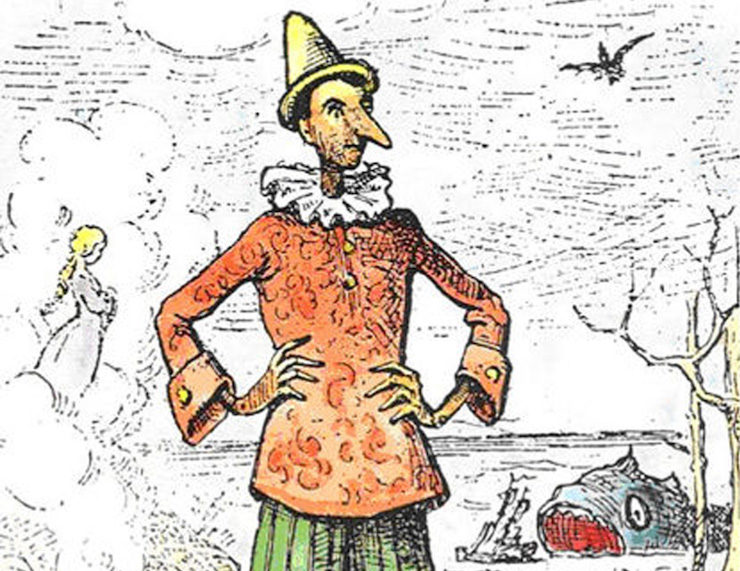
Best book/source material: Rather an unfair comparison/category, given that the source material ranged from lengthy works by two of the greatest novelists of the 19th century to a picture book with almost no words at all, in between including two 17th century works from a pirate attempting to save his deservedly sullied reputation, a story told mostly in ancient vase paintings, a meditation on responding to death and terror, a tale filled with donkey violence, a pulp work churned out for quick cash, various fairy tales, and books about mice.
Within this category, however, one work stood out: Notre-Dame de Paris/Hunchback of Notre Dame, which despite the multiple digressions about CHURCH ARCHITECTURE was one hell of a read, in the full sense of that word. Recommended.
Book that most surprised me: Pinocchio. I was expecting an adorable little story about a puppet. What I got was a lot of donkey violence.
Runner-up: The Fox and the Hound. Again, I was expecting an adorable story about a fox and a hound. What I got was dead puppies.
Most irritating source material: The writings of Captain John Smith. After reading them, I began to feel considerably more sympathetic towards Disney’s decision to ignore virtually everything Smith wrote.
Most disturbing source material: Another difficult choice. Let’s call it a tie between Sleeping Beauty, what with all of the rape, cannibalism and adultery, and The Fox and the Hound, with the dead puppies.
Notes on the Films
Best Disney animated film? This question is too hard. Instead, let’s try:
Favorite film of small me: The Many Adventures of Winnie the Pooh, aka BOUNCING TIGGER IS THE BEST FILM EVER. My four year old self remains firm on this point.
- Runner-up: Cinderella. That dress! My six year old self remains firm on this point.
- 2nd runner-up: “Duck Dodgers in the 24 ½th century!” Ok, technically that’s the wrong franchise and wasn’t covered in this Read-Watch, but it’s a great cartoon and everyone should go see it.
Favorite film of grown-up me: Lilo & Stitch.
- Runner-up: Also Lilo & Stitch. Look, there’s a reason those slippers were necessary.
- 2nd Runner-up: Sleeping Beauty
Favorite films of Tor.com commenters: Quite a lot of disagreement here, with votes in for Fantasia, Sleeping Beauty, Robin Hood, The Little Mermaid, Beauty and the Beast, The Lion King, The Emperor’s New Groove, Wreck-It-Ralph, Moana, and probably a few I missed.
Worst film: Chicken Little.
Trying to choose between Chicken Little and Home on the Range was a tough call, what with the massive plot holes of the first and the yodeling in the second. In the end, though, I had to go with Chicken Little, for sheer overall offensiveness and ugly character design. At least Home on the Range has a few lovely backgrounds, and some of the animals are cute. It’s not a huge saving grace, but it’s a lot more than Chicken Little has.
- Runner-up: Home on the Range.
- 2nd Runner-up: From the classic period: a tie between the package films Fun and Fancy Free and Melody Time. The first suffers from a dull first half and an even duller bridging section, which even puppets can’t save, and the second features the weakest collection of cartoons of any of the package films, with virtually no standouts. Both films have their moments, but not enough moments to save them.
- Dishonorable mentions: The Sword in the Stone, probably the weakest non-package film from the Walt Disney years; The Black Cauldron, featuring unusually sloppy animation, a whiny hero, a bland love interest, a bland villain, and plot holes galore; and Atlantis: the Lost Empire, another ambitious film filled with plot holes and clichés galore.
Most unintentionally horrifying film: Mickey’s Christmas Carol, wherein we learned that (a) Daisy Duck may very well be having a thing with Donald’s Uncle Scrooge and (b) even worse, Daisy Duck may be killing her neighbors and serving them up for Christmas dinner YIKES DAISY.
Most intentionally horrifying film: Victory Through Air Power, intended to convince already convinced viewers that major German and Japanese invasions of the United States were imminent and could only be stopped by a strategic focus on air power.
Most genuinely horrifying film no matter what the intentions: Dumbo. Between cruelty to a small cute elephant and that demented pink elephants sequence, Dumbo has understandably left generations of small children quaking in terror.
- Runner-up: Bambi. Between the death of Bambi’s mother (sniffle) and that forest fire, this film would probably win the award for “Most Traumatic Disney Film Ever,” if not for Dumbo.
- Is this a case where small me is influencing the final results? Nope. Since I didn’t see Dumbo until I was slightly bigger and able to handle it, the film that terrified small me the most was Snow White and the Seven Dwarfs, which for reasons of artistry and taste decided not to show the dead body of the witch, leaving small me convinced that the Evil Witch was going to climb out of that cliff and EAT EVERYBODY including the dwarfs and Snow White. So THAT WAS TERRIFYING THANK YOU DISNEY.
- Dishonorable mention: The trailer for Cars 3 which made several small children waiting to see Moana burst into tears.
Biggest box office, not adjusted for inflation: Frozen, $1.276 billion, not including ticket sales for special 2014-2016 summer matinee releases, placing Frozen in the top ten grossing films of all time as of this writing.
- Runner-up: Zootopia, $1.024 billion.
(Note: both numbers are expected to increase slightly thanks to limited theatrical matinee releases in summer months, but remain ahead of Moana, which has currently taken in a respectable $402 million at the box office, but is expected to see falling ticket sales in coming months. Much thanks to Brad Brevet of Box Office Mojo for these estimates and predictions.)
Biggest box office, adjusted for inflation: Snow White and the Seven Dwarfs, still the only Disney animated film to make the “Top Ten Box Office, Adjusted for Inflation” all-time list, partly thanks to multiple theatrical releases.
- Runner-up: The Lion King, which has also benefited from multiple theatrical releases. This does not include revenues from the Broadway musical based on the film, The Lion King, which as of this writing is Broadway’s third longest running show (beaten only by The Phantom of the Opera and Chicago), and its most profitable.
Biggest box office disappointment: Treasure Planet, as of this writing still one of the biggest bombs in Hollywood history, let alone Disney history. It has yet to regain production costs. Disney has not bothered to make a Broadway adaptation.
- Runner-up: The Black Cauldron, a major box office bomb which failed to earn back production costs in its initial release, and regained only some of that ground in the later VHS/DVD releases.
- Honorable box office disappointment mention: Victory Through Air Power, which was not intended to earn a profit for the studio, and didn’t.
Film that took the longest to earn a profit: Fantasia, which needed five separate theatrical releases before it earned back its costs, and only became a moneymaker after its VHS release decades after its original release in World War II.
Film that became a blockbuster money maker decades after its original release: Sleeping Beauty, a major flop on its initial release, needed two more releases to start earning back its costs. The launch of the Disney Princess franchise, however, which placed Aurora in a prominent role, has turned the previous failure into one of Disney’s biggest assets.
Most profitable franchise/biggest overall revenue generator: As of late 2016 reports, Frozen, with merchandise sales estimated at $107 billion and climbing.
- Runners-up: The Disney Princess franchise and Winnie the Pooh.
Biggest tearjerker: Dumbo. That poor little elephant.
- Runner-up: The Lion King. Poor little Simba.
Biggest laughs: The Emperor’s New Groove. “Why do we even HAVE that lever?”
- Runner-up: Hercules.
Greatest/best animated sequences: Another unfair category, given that the films not only span close to 90 years of film and technical development, but also include multiple techniques, from lavish hand drawn art to the later computer assisted and computer art. So I’ve broken down this section into three categories: the classic period, the Renaissance period, and the Revival period, ignoring the various films that appeared between those films since for the most part, they did not stand out for particularly good, let alone great, animated sequences.
Classic (Snow White and the Seven Dwarfs (1937) to The Jungle Book (1967); hand pencils/coloring, hand inking or xerography)
Tie: The Nutcracker Suite sequence from Fantasia and the caravan sequence from Pinocchio.
Even choosing just two scenes for a tie was difficult. But for sheer beauty, nothing done in the classic Disney period can match The Nutcracker Suite sequence. And for sheer ingenuity and complexity, nothing until Zootopia, created with the assistance of computers, came anything close to the caravan sequence in Pinocchio, featuring a moving Pinocchio in a swinging cage in a moving caravan with a separately moving Jiminy Cricket, all of which had to be carefully planned by animators to mimic both the bounce of a caravan and the swing of a cage.
With a terrified puppet.
- Runner-up: The Night on Bald Mountain sequence from Fantasia.
- 2nd Runner-up: The final confrontation with Maleficent in Sleeping Beauty.
- 3rd Runner-up: The pink elephants sequence in Dumbo, a sequence that Disney animators continued to reference and play homage to in a number of later films.
- Honorable mentions: Maleficent summoning Aurora to the spinning wheel and the dancing imps from Sleeping Beauty; mastering the look of animated flight in both Victory Through Air Power and Peter Pan; and the first mastery of dancing characters in Snow White and the Seven Dwarfs, a sequence that worked so well that Disney animators later traced it for Robin Hood.
- Honorable technical mentions: The development of the multiplane camera for Snow White, allowing animation to give mere drawings the illusion of camera movement and depth, and xerography, which not only kept production costs feasible, but started the slow movement towards computer animation, eventually bringing us to the Pixar and Disney Revival films.
Renaissance (The Little Mermaid (1989) through Tarzan/Fantasia 2000; hand pencils, CAPS system, some computer generated imagery)
Almost no contest here: the opening sequence and the wildebeest stampede sequence from The Lion King, the hands down greatest animated sequences Disney produced between the classic period and their first mastery of computer animation, Tangled. The sequences are remarkable not only for their beauty, but for their technical accomplishment, a mingling of revolutionary animation camera angles, special effects work (note the lighting and the dust clouds) and hand drawn animation.
- Runner-up: The “Be Our Guest” and Belle explores the castle sequences, Beauty and the Beast.
- 2nd runner-up: The “Hellfire” sequence, Hunchback of Notre Dame.
- 3rd runner-up: The Firebird Suite sequence, Fantasia 2000.
- Honorable technical mention: The CAPS system, initially developed for The Rescuers Down Under, which not only allowed animated films to mimic the look of moving cameras and helicopter shots, but also helped pave the road for computer animation.
Revival (Bolt (2007) to the present day; mixture of hand pencils and computer animation)
Maui’s sentient tattoos in Moana, an artistic and technical highlight.
- Runner-up: The “Let it Go,” sequence, Frozen.
- 2nd runner-up: The floating lantern sequence, Tangled.
- 3rd runner-up: “We Know the Way,” sequence, Moana.
- Honorable Technical mentions: The addition of Hyperion rendering software for Big Hero 6, which allowed both Zootopia and Moana to achieve previously unheard of realism in lighting, shading and coloring; Rapunzel’s hair in Tangled.
Weirdest Disney film: The Three Caballeros. I don’t know what anyone was thinking at the end there, but… it was different.
- Runner-up: No runner-up, though the pink elephant sequence in Dumbo is a better animated distant second.
Best use of music in an animated Disney film: Fantasia.
- Runner-up: Fantasia 2000
- 2nd runner-up: The Elvis songs in Lilo & Stitch
Worst use of music in an animated Disney film: All of the yodeling in Home on the Range.
- Runner-up: Chicken Little crooning “WE ARE THE CHAMPIONS!” in Chicken Little.
Those two were so bad, nothing else—even the dinosaurs mournfully shuffling their way to death to the sounds of Igor Stravinsky in Fantasia could even come close, but if I did have to pick a second runner-up….
….No. It’s those two. Hands down.
Best Disney song: I suspect that Disney would probably suggest their signature “When You Wish Upon a Star,” from Pinocchio, or “Be Our Guest,” from Beauty and the Beast, or “Circle of Life,” from The Lion King, or “Bare Necessities,” from The Jungle Book.
Nah.
“Under the Sea,” from The Little Mermaid.
- Runners-up: The songs mentioned above.
Best Disney villain song: A tie between “Poor Unfortunate Souls” from The Little Mermaid, and “Be Prepared” from The Lion King.
- Runner-Up: Hellfire, from The Hunchback of Notre Dame.
Worst Disney song: Most bad Disney songs fall into the category of “unmemorable” rather than “bad,” with one outright exception, “What Made the Red Man Red,” Peter Pan, a song memorable for all the wrong reasons: it’s one of the most racist moments in any Disney film, barring the films/sequences currently buried in the Disney vaults.
- Runner-up: “A Guy Like You,” Hunchback of Notre Dame, a song intended to showcase the many talents of Jason Alexander, one that instead introduces arguably the single most callous moment in a Disney film: as the city of Paris starts burning down around them, the gargoyles sing this cheerful little number to assure Quasimodo that sure, sure, Esmeralda loves him. Two minutes later, Quasimodo catches Esmeralda kissing another guy, so like, YES, THAT WENT WELL.
- 2nd Runner-up: “Fixer-Upper,” Frozen. On its own, not a very good song; in context, HEY ANNA IS DYING AND THE ENTIRE KINGDOM IS FREEZING TO DEATH PERHAPS WE COULD SING ABOUT THIS LATER, THANKS. It doesn’t quite tarnish the entire film, the way “A Guy Like You” does, but it’s certainly out of place.
Worst Disney villain song: “Yodel-Adle-Eedle-Idle-Oo,” Home on the Range. As this post has shown, I still haven’t recovered.
Most foreseen use of a Disney song for a commercial: “Be Our Guest,” from Beauty and the Beast, a song Disney continues to use to advertise its various cruise ships, theme parks and resorts.
Least foreseen use of a Disney song for a commercial: “I’ve Got No Strings,” from Pinocchio, that 75 years later was used by Beats Wireless to show us that celebrities are as into electronic devices are we are.
Least necessary update to a discussion generated in the comments for Pocahontas, but one I’m making anyway: As of now, at least, the success of the Star Wars: A Galactic Spectacular fireworks show at Disney’s Hollywood Studios has not led to any announcements of upcoming changes to Fantasmic.
Ok, ok, so after all that time wasted explaining that Fantasmic is not actually changing that much…
Best Disney film? Despite the bland heroine, I’m going to go with Sleeping Beauty, for a combination of exquisite, lavish animation, background art, glorious villain and dramatic use of Tchaikovsky’s original ballet score.
- Runners-up include, from the classic period, Fantasia and Pinocchio, from the Disney Renaissance, The Lion King and Beauty and the Beast, and from the Revival period, Wreck-It-Ralph and Zootopia.
- Honorable mention: Who Framed Roger Rabbit?, which if not technically a product of the Disney Animation Studios, remains one of the most innovative films in animation history, and continues to hold up remarkably well decades later.
What’s coming up next: Two related projects—a journey through fairy tales, myths and their retellings, and a monthly Pixar rewatch!
Mari Ness lives in central Florida.










